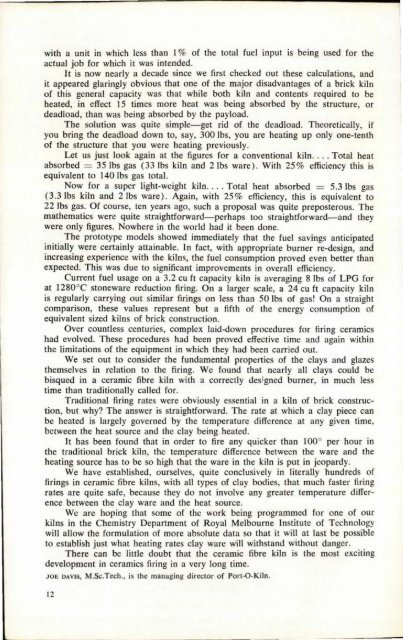Pottery in Australia Vol 17 No 1 Autumn 1978
Create successful ePaper yourself
Turn your PDF publications into a flip-book with our unique Google optimized e-Paper software.
with a umt In which less than I % of the total fuel <strong>in</strong>put is be<strong>in</strong>g used for the<br />
actual job for which it was <strong>in</strong>tended.<br />
It is now nearly a decade s<strong>in</strong>ce we first checked out these calculations, and<br />
it appeared glar<strong>in</strong>gly obvious that one of the major disadvantages of a brick kiln<br />
of this general capacity was that while both kiln and contents required to be<br />
heated, <strong>in</strong> effect 15 times more heat was be<strong>in</strong>g absorbed by the structure, or<br />
deadload, than was be<strong>in</strong>g absorbed by the payload.<br />
The solution was quite simple-get rid of the deadload. Theoretically, if<br />
you br<strong>in</strong>g the dead load down to, say, 3001bs, you are heat<strong>in</strong>g up only one-tenth<br />
of the structure that you were heat<strong>in</strong>g previously.<br />
Let us just look aga<strong>in</strong> at the figures for a conventional kiln .... Total heat<br />
absorbed = 351bs gas (33 Ibs kiln and 2lbs ware) . With 25% efficiency this is<br />
equivalent to 140 Ibs gas total.<br />
<strong>No</strong>w for a super light-weight kiln .... Total heat absorbed = 5.3 lbs gas<br />
(3.3Ibs kiln and 21bs ware). Aga<strong>in</strong>, with 25 % efficiency, this is equivalent to<br />
22 Ibs gas. Of course, ten years ago, such a proposal was quite preposterous. The<br />
mathematics were quite straightforward-perhaps too straightforward-and they<br />
were only figures. <strong>No</strong>where <strong>in</strong> the world had it been done.<br />
The prototype models showed immediately that the fuel sav<strong>in</strong>gs anticipate


















